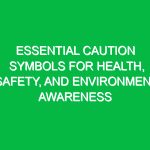Introduction
In our daily lives, we encounter various signs and symbols that communicate important information about health, safety, and the environment (HSE). These danger signs and symbols serve as crucial tools in preventing accidents, promoting safety, and protecting the environment. Understanding these signs is not just beneficial; it is essential for anyone engaged in industrial work, construction, or even everyday activities. As we delve into the world of danger signs and symbols, we will explore their significance, types, regulations, and best practices for effective communication in HSE contexts.
The Importance of Danger Signs and Symbols
Danger signs and symbols function as visual cues that alert individuals to potential hazards and risks. Whether you are on a construction site, in a laboratory, or walking through a public park, these signs guide behavior and actions to prevent accidents and injuries. One of the primary reasons for their importance is clarity. A well-designed sign can communicate complex messages at a glance, making it easier for people to respond quickly to potential dangers.
Real-life experiences illustrate this point. For instance, consider a busy industrial facility where machinery operates continuously. A simple sign indicating “Caution: High Voltage” can prevent serious injuries or fatalities by alerting workers to the presence of electrical hazards. Similarly, “Wet Floor” signs in public spaces help reduce slip-and-fall accidents, showcasing how effective communication can directly influence safety outcomes.
Types of Danger Signs and Symbols
1. Warning Signs
Warning signs are among the most recognizable danger signs and symbols. They typically use a yellow background with a black symbol or text and indicate the presence of a potential hazard. For example, a triangular sign with an exclamation mark signifies caution, alerting individuals to be vigilant about possible dangers in the vicinity.
- Examples: “Caution: Slippery When Wet,” “Warning: High Noise Area”
2. Prohibition Signs
Prohibition signs communicate actions that are not allowed in certain areas. These signs have a red circle with a diagonal line through it, accompanied by a black symbol or text. Their clear imagery serves to prevent dangerous behaviors and maintain safety protocols.
- Examples: “No Smoking,” “Do Not Enter”
3. Mandatory Signs
Mandatory signs indicate actions that must be taken to ensure safety. These signs typically feature a blue circle with white symbols or text. They are essential for compliance with safety regulations and guidelines.
- Examples: “Wear Safety Goggles,” “Hard Hats Must Be Worn”
4. Emergency Information Signs
Emergency information signs provide crucial information that can save lives during emergencies. They often use green backgrounds with white symbols and indicate the location of emergency equipment, exits, and first aid stations.
- Examples: “First Aid Kit,” “Emergency Exit”
5. Environmental Safety Signs
Environmental safety signs focus on protecting natural resources and promoting sustainable practices. They often feature symbols related to waste disposal, hazardous materials, and wildlife conservation.
- Examples: “Recycle,” “Hazardous Waste Disposal”
Key Components of Effective Danger Signs and Symbols
To serve their purpose effectively, danger signs and symbols must be designed with key components in mind:
1. Clarity and Simplicity
Effective signs should be easy to understand at a glance. Using simple language, clear symbols, and standardized colors allows for quick recognition. For instance, a sign that reads “Chemical Storage” alongside a simple illustration of a storage container is far more effective than lengthy text descriptions.
2. Visibility
Signs must be placed in locations where they are easily visible, and their design should consider factors such as size, color contrast, and lighting. In a noisy factory, a brightly colored sign may capture attention better than a muted one.
3. Consistency
Using standardized symbols and colors is crucial for effective communication. The International Organization for Standardization (ISO) and the American National Standards Institute (ANSI) provide guidelines for creating consistent safety signs. Adhering to these standards ensures that people across different regions and industries can understand the signs.
4. Regular Maintenance
Signs should be regularly inspected and maintained to ensure they remain visible and legible. Faded, damaged, or obscured signs can lead to misunderstandings and increased risk of accidents.
Real-Life Examples and Case Studies
Understanding the practical application of danger signs and symbols is essential. A notable case study involves a manufacturing facility that faced numerous safety incidents due to a lack of clear communication regarding hazardous materials. The introduction of standardized warning signs, including “Caution: Flammable Materials” and “Toxic Gas Alert,” drastically reduced accidents. Workers reported feeling more aware of their surroundings, leading to increased safety compliance and a 40% decrease in incident reports within six months.
Another example can be drawn from a public park where environmental safety signs were implemented. Signs indicating “No Littering” and “Wildlife Habitat – Do Not Disturb” helped foster a culture of respect for nature among visitors. The park management noticed a significant reduction in littering and improved wildlife sightings, demonstrating the effectiveness of positive reinforcement through clear signage.
Regulations and Standards Governing Danger Signs and Symbols
In the HSE domain, regulations and standards play a critical role in ensuring the appropriate use of danger signs and symbols. For instance, the Occupational Safety and Health Administration (OSHA) in the United States mandates specific signage requirements to protect workers. OSHA’s standards specify that employers must provide appropriate signs to inform workers of potential hazards, and failure to comply can result in penalties.
Furthermore, the Globally Harmonized System (GHS) of Classification and Labeling of Chemicals provides guidelines for labeling hazardous materials, ensuring consistency and understanding across international borders. Companies that adhere to these regulations not only enhance workplace safety but also demonstrate a commitment to responsible practices.
Best Practices for Implementing Danger Signs and Symbols
To maximize the effectiveness of danger signs and symbols, organizations should consider the following best practices:
1. Conduct a Risk Assessment
Before placing signs, conduct a thorough risk assessment to identify areas where hazards exist. This process involves evaluating the potential risks and determining the most effective signage to mitigate them.
2. Train Employees
Training employees on the meaning and significance of danger signs and symbols is essential. Regular training sessions can help reinforce the importance of safety and ensure that everyone understands how to respond to different signs.
3. Engage in Regular Reviews
Regularly review and update signage as necessary. Changes in the workplace, such as new equipment or processes, may require additional or modified signs.
4. Foster a Safety Culture
Encouraging a culture of safety within the organization can enhance the effectiveness of danger signs and symbols. This can be achieved through open communication, feedback mechanisms, and recognizing employees who prioritize safety.
Conclusion
Danger signs and symbols are integral to promoting health, safety, and environmental sustainability. Their design and implementation play a pivotal role in preventing accidents and fostering a culture of safety. As we navigate our daily lives, recognizing and responding to these signs can significantly reduce risks and enhance our overall well-being.
By understanding the various types of danger signs and symbols, adhering to regulations, and implementing best practices, we can create safer workplaces and communities. Remember, safety is a shared responsibility, and awareness begins with recognizing the signs. So next time you see a caution sign, take a moment to appreciate its role in keeping us safe and informed.


